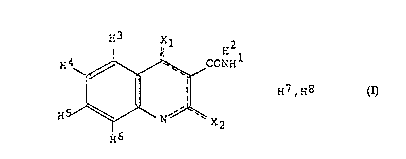Some of the information on this Web page has been provided by external sources. The Government of Canada is not responsible for the accuracy, reliability or currency of the information supplied by external sources. Users wishing to rely upon this information should consult directly with the source of the information. Content provided by external sources is not subject to official languages, privacy and accessibility requirements.
Any discrepancies in the text and image of the Claims and Abstract are due to differing posting times. Text of the Claims and Abstract are posted:
| (12) Patent Application: | (11) CA 2185136 |
|---|---|
| (54) English Title: | NEW USE OF QUINOLINE-3-CARBOXAMIDE COMPOUNDS |
| (54) French Title: | NOUVELLE UTILISATION DE QUINOLEINE-3-CARBOXAMIDES |
| Status: | Deemed Abandoned and Beyond the Period of Reinstatement - Pending Response to Notice of Disregarded Communication |
| (51) International Patent Classification (IPC): |
|
|---|---|
| (72) Inventors : |
|
| (73) Owners : |
|
| (71) Applicants : | |
| (74) Agent: | GOWLING WLG (CANADA) LLP |
| (74) Associate agent: | |
| (45) Issued: | |
| (86) PCT Filing Date: | 1995-03-08 |
| (87) Open to Public Inspection: | 1995-09-14 |
| Availability of licence: | N/A |
| Dedicated to the Public: | N/A |
| (25) Language of filing: | English |
| Patent Cooperation Treaty (PCT): | Yes |
|---|---|
| (86) PCT Filing Number: | PCT/SE1995/000244 |
| (87) International Publication Number: | WO 1995024195 |
| (85) National Entry: | 1996-09-09 |
| (30) Application Priority Data: | ||||||
|---|---|---|---|---|---|---|
|
The use of an anti-
inflammatory bowel disease
quinoline-3-carboxamide
compound comprising
structure (I), optionally with
substituents for the hydrogen
atoms shown: (H1-9), or a
pharmaceutically acceptable
salt of said compound where:
(a) -------- represents that
there are two conjugated
double bonds between the
atoms comprised by the
dashed line; (b) X1 and X2 are
separately selected from an oxygen atom or an NH9 group, said X1 and X2 being bound by a single bond to the ring when attached to
H7 or H8 and by a double bond when not bound to H7 or H8; (c) H1-9 are hydrogens with the provision that H9 is only present when at
least one of X1 and X2 is the NH9 group; (d) H7 and H8 are hydrogens that are attached to different atoms selected among X1, X2 and
the nitrogen atom (N) in the quinoline ring, for the manufacture of a composition intended for treating inflammatory bowel disease or
conditions associated with this disease. Also described are methods for treating inflammatory bowel disease or conditions associated
with this disease in which methods the above compounds are administered to a living body. Particularly preferred compounds are
N-phenyl-N-methyl-1,2-dihydro-4-hydroxy-1-methyl-2-oxo-quinoline-3-carboxamide or a salt thereof.
Utilisation, contre les affections intestinales inflammatoires, d'un composé quinoléine-3-carboxamide présentant la structure (I) et présentant éventuellement des substituants pour les atomes d'hydrogène indiqués dans ladite structure (H<1-9>), ou sel pharmaceutiquement acceptable dudit composé. Dans cette formule: (a) -------- signifie qu'il existe deux liaisons doubles conjuguées liaison entre les atomes entourés par les pointillés; (b) X1, X2 sont choisis individuellement parmi un atome d'oxygène ou un groupe NH<9>, lesdits X1 et X2 étant liés par une liaison simple au cycle lorsqu'ils sont liés à H<7> ou H<8> et par une liaison double lorsqu'ils ne sont pas liés à H<7> ou H<8>; (c) H<1-9> sont des atomes d'hydrogène, sous réserve que H<9> ne soit présent que lorsque au moins l'un des éléments X1 et X2 correspond au groupe NH<9>; (d) H<7> et H<8> sont des atomes d'hydrogène qui sont liés à différents atomes choisis parmi X1, X2 et l'atome d'azote (N) dans le cycle quinoléine, pour l'élabotraion d'une composition destinée au traitement d'affections intestinales inflammatoires ou des états liés à cette pathologie. L'invention porte également sur des méthodes de traitement d'affections intestinales inflammatoires ou d'états liés à cette pathologie, dans lesquelles lesdits composés sont administrés à un organisme vivant. Les composés préférés sont en particulier N-phényl-N-méthyl-1,2-dihydro-4-hydroxy-1-méthyl-2-oxo-quinoléine-3-carboxamide ou un sel de cette substance.
Note: Claims are shown in the official language in which they were submitted.
Note: Descriptions are shown in the official language in which they were submitted.

2024-08-01:As part of the Next Generation Patents (NGP) transition, the Canadian Patents Database (CPD) now contains a more detailed Event History, which replicates the Event Log of our new back-office solution.
Please note that "Inactive:" events refers to events no longer in use in our new back-office solution.
For a clearer understanding of the status of the application/patent presented on this page, the site Disclaimer , as well as the definitions for Patent , Event History , Maintenance Fee and Payment History should be consulted.
| Description | Date |
|---|---|
| Inactive: IPC from MCD | 2006-03-12 |
| Time Limit for Reversal Expired | 2000-03-08 |
| Application Not Reinstated by Deadline | 2000-03-08 |
| Deemed Abandoned - Failure to Respond to Maintenance Fee Notice | 1999-03-08 |
| Application Published (Open to Public Inspection) | 1995-09-14 |
| Abandonment Date | Reason | Reinstatement Date |
|---|---|---|
| 1999-03-08 |
The last payment was received on
Note : If the full payment has not been received on or before the date indicated, a further fee may be required which may be one of the following
Please refer to the CIPO Patent Fees web page to see all current fee amounts.
| Fee Type | Anniversary Year | Due Date | Paid Date |
|---|---|---|---|
| MF (application, 3rd anniv.) - standard | 03 | 1998-03-09 | 1998-02-18 |
| MF (application, 2nd anniv.) - standard | 02 | 1997-03-10 |
Note: Records showing the ownership history in alphabetical order.
| Current Owners on Record |
|---|
| PHARMACIA & UPJOHN AB |
| Past Owners on Record |
|---|
| AGNETA SVEDBERG |
| BO NILSSON |
| PER GJORSTRUP |